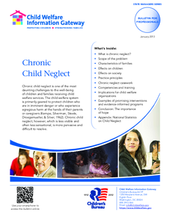This Child Welfare Information Gateway bulletin for professionals discusses what constitutes chronic neglect, and reviews ways to work with families experiencing chronic neglect, including critical elements of successful casework practice, examples of what agencies are doing, and ways agencies can integrate child welfare approaches to chronic neglect with prevention and early intervention efforts. Children who experienced neglect in the US make up approximately three quarters of children identified as maltreatment victims. Additionally, cases involving neglect are more likely to recur and tend to so more quickly than abuse cases. Chronic child neglect is defined as a parent or caregiver’s ongoing, serious pattern of deprivation of a child’s basic physical, developmental, and/or emotional needs for healthy growth and development. Chronic neglect differs from incident-based neglect in terms of duration, frequency (e.g., number of reports), duration of need for services, and referrals for multiple types of maltreatment. Several parental stressors are associated with chronic neglect, including poverty, mental health issues, and substance abuse. Of all forms of maltreatment, neglect has the strongest relationship to poverty. This relationship is not causal but contributory—neglect is strongly associated with measures of socioeconomic disadvantage, which include welfare dependence, homelessness, low levels of education, and single-parent families—as well as limited income.
The bulletin reviews the evidence on the impact of chronic neglect on children, as well as on society. It highlights the implications for child welfare agencies including the fact that approaches to neglect need to move away from incidence-based intervention and assessment and toward assessment of cumulative harm, with intervention and support aimed at the long-term. It draws on good practices that have been shown to work with families in the complex context provided by chronic neglect that often involves families facing intergenerational issues, and identifies useful tools and resources available, including specialized training to build the competencies needed by caseworkers to work effectively in partnership with families and children affected. Two programs are also introduced as examples of promising interventions and evidenced-informed practices, the Family Asset Builder (FAB), implemented in two Minnesota counties in February 2011 by Casey Family Programs and the American Humane Association and the Chronic Neglect worker approach developed by the child welfare system in St. Louis, Missouri in 1995.
©Childrenâs Bureau, Administration on Children, Youth and Families, Administration for Children and Families, U.S. Department of Health and Human Services.

